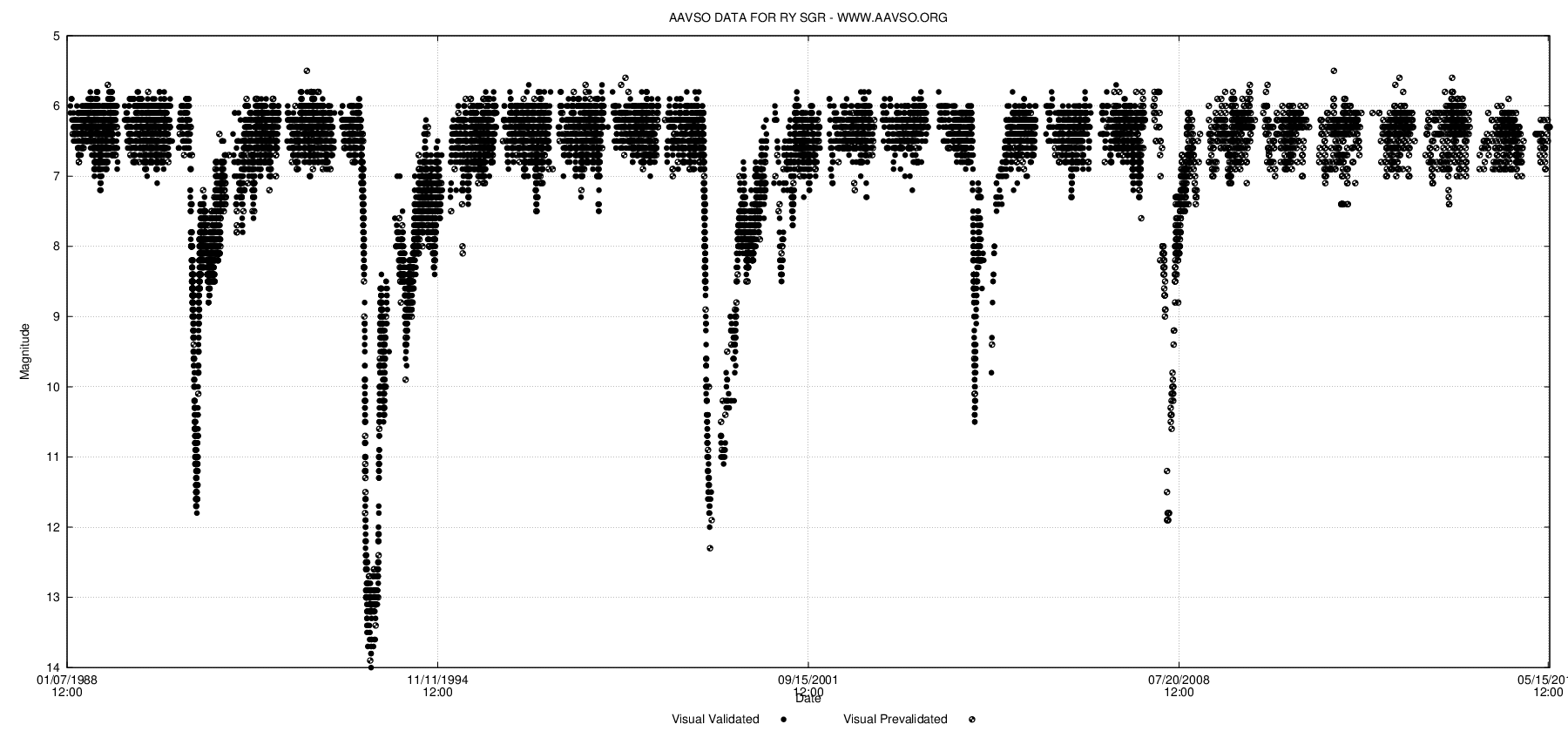|
UX Antliae
UX Antliae is a post-AGB and R Coronae Borealis variable star that has a base apparent magnitude of around 11.85, with irregular dimmings down to below magnitude 18.0. Researchers David Kilkenny and J.E. Westerhuys of the South African Astronomical Observatory confirmed that UX Antliae was an R Coronae Borealis variable in 1990 after noting the similarity of its spectrum to the RCB star W Mensae W Mensae (W Men) is an unusual yellow supergiant star in the Large Magellanic Cloud in the southern constellation Mensa. It is an R Coronae Borealis variable and periodically decreases in brightness by several magnitudes. W Men is very .... It had been suspected of being one since 1940, but had been little-studied and exhibited no characteristic declines between 1975 and 1990. Assuming that its absolute magnitude is around -5, it has been estimated as lying 25000 parsecs distant from Earth. Kilkenny and Westerhuys noted that its spectrum fit with that of a star of ... [...More Info...] [...Related Items...] OR: [Wikipedia] [Google] [Baidu] |
AAVSO
The American Association of Variable Star Observers (AAVSO) is an international nonprofit organization, founded in 1911, focused on coordinating, analyzing, publishing, and archiving variable star observations made largely by amateur astronomers. The AAVSO creates records that establish light curves depicting the variation in brightness of a star over time, and makes them available to professional astronomers, researchers, and educators. Since professional astronomers do not have the time or the resources to monitor every variable star, astronomy is one of the few sciences where amateurs can make genuine contributions to scientific research. During 2011, the 100th year of the AAVSO's existence, the 20-millionth variable star observation was received into the database. The AAVSO International Database (AID) stores over 35 million observations as of 2019. The organization receives nearly 1,000,000 observations annually from around 2,000 professional and amateur observers and is quot ... [...More Info...] [...Related Items...] OR: [Wikipedia] [Google] [Baidu] |
R Coronae Borealis Variables
An R Coronae Borealis variable (abbreviated RCB, R CrB) is an eruptive variable star that varies in luminosity in two modes, one low amplitude pulsation (a few tenths of a magnitude), and one irregular, unpredictably-sudden fading by 1 to 9 magnitudes. The prototype star R Coronae Borealis was discovered by the English amateur astronomer Edward Pigott in 1795, who first observed the enigmatic fadings of the star. Only about 150 RCB stars are currently known in our Galaxy while up to 1000 were expected, making this class a very rare kind of star. It is increasingly suspected that R Coronae Borealis (RCB) stars – rare hydrogen-deficient and carbon-rich supergiant stars – are the product of mergers of white-dwarfs in the intermediary mass regime (total mass between 0.6 and 1.2 ). The fading is caused by condensation of carbon to soot, making the star fade in visible light while measurements in infrared light exhibit no real luminosity decrease. R Coronae Borealis variables are ... [...More Info...] [...Related Items...] OR: [Wikipedia] [Google] [Baidu] |
Antlia
Antlia (; from Ancient Greek ''ἀντλία'') is a constellation in the Southern Celestial Hemisphere. Its name means " pump" in Latin and Greek; it represents an air pump. Originally Antlia Pneumatica, the constellation was established by Nicolas-Louis de Lacaille in the 18th century. Its non-specific (single-word) name, already in limited use, was preferred by John Herschel then welcomed by the astronomic community which officially accepted this. North of stars forming some of the sails of the ship Argo Navis (the constellation Vela), Antlia is completely visible from latitudes south of 49 degrees north. Antlia is a faint constellation; its brightest star is Alpha Antliae, an orange giant that is a suspected variable star, ranging between apparent magnitudes 4.22 and 4.29. S Antliae is an eclipsing binary star system, changing in brightness as one star passes in front of the other. Sharing a common envelope, the stars are so close they will one day merge to form a singl ... [...More Info...] [...Related Items...] OR: [Wikipedia] [Google] [Baidu] |
R Coronae Borealis
R Coronae Borealis is a low-mass yellow supergiant star in the constellation of Corona Borealis. It is the prototype of the R Cor Bor class of variable stars, which fade by several magnitudes at irregular intervals. R Coronae Borealis itself normally shines at approximately magnitude 6, just about visible to the naked eye, but at intervals of several months to many years fades to as faint as 15th magnitude. Over successive months it then gradually returns to its normal brightness, giving it the nickname "reverse nova", after the more common type of star which rapidly increases in brightness before fading. Nomenclature R Coronae Borealis is a faint naked eye star, but does not have any traditional names. Johann Bayer did not give it a Greek letter designation although it is marked on his map. John Flamsteed numbered all the Bayer stars but did not add any additional designations for fainter stars, so R Coronae Borealis does not appear in either of these two catalogu ... [...More Info...] [...Related Items...] OR: [Wikipedia] [Google] [Baidu] |
Effective Temperature
The effective temperature of a body such as a star or planet is the temperature of a black body that would emit the same total amount of electromagnetic radiation. Effective temperature is often used as an estimate of a body's surface temperature when the body's emissivity curve (as a function of wavelength) is not known. When the star's or planet's net emissivity in the relevant wavelength band is less than unity (less than that of a black body), the actual temperature of the body will be higher than the effective temperature. The net emissivity may be low due to surface or atmospheric properties, including greenhouse effect. Star The effective temperature of a star is the temperature of a black body with the same luminosity per ''surface area'' () as the star and is defined according to the Stefan–Boltzmann law . Notice that the total (bolometric) luminosity of a star is then , where is the stellar radius. The definition of the stellar radius is obviously not straightf ... [...More Info...] [...Related Items...] OR: [Wikipedia] [Google] [Baidu] |
W Mensae
W Mensae (W Men) is an unusual yellow supergiant star in the Large Magellanic Cloud in the southern constellation Mensa. It is an R Coronae Borealis variable and periodically decreases in brightness by several magnitudes. W Men is very distant, being located in the neighboring galaxy Large Magellanic Cloud, where it lies on the southern metal-deficient edge. Despite its high luminosity, the star has a maximum apparent brightness of +13.8m, too dim to be visible in a small telescope. Its radius has been calculated to be 61 times that of the Sun. The variability of W Men was discovered in 1927 by W. J. Luyten. It belongs to the very rare R Coronae Borealis R Coronae Borealis is a low-mass yellow supergiant star in the constellation of Corona Borealis. It is the prototype of the R Cor Bor class of variable stars, which fade by several magnitudes at irregular intervals. R Coronae Boreali ... class of variables which are often called "inverse novae" since ... [...More Info...] [...Related Items...] OR: [Wikipedia] [Google] [Baidu] |
South African Astronomical Observatory
South African Astronomical Observatory (SAAO) is the national centre for optical and infrared astronomy in South Africa. It was established in 1972. The observatory is run by the National Research Foundation of South Africa. The facility's function is to conduct research in astronomy and astrophysics. The primary telescopes are located in Sutherland, which is from Observatory, Cape Town, where the headquarters is located. The SAAO has links worldwide for scientific and technological collaboration. Instrumental contributions from the South African Astronomical Observatory include the development of a spherical aberration corrector and the Southern African Large Telescope (SALT). The Noon Gun on Cape Town's Signal Hill is fired remotely by a time signal from the Observatory. History The history of the SAAO began when the Royal Observatory at the Cape of Good Hope was founded in 1820, the first scientific institution in Africa. Construction of the main buildings was complet ... [...More Info...] [...Related Items...] OR: [Wikipedia] [Google] [Baidu] |
Apparent Magnitude
Apparent magnitude () is a measure of the brightness of a star or other astronomical object observed from Earth. An object's apparent magnitude depends on its intrinsic luminosity, its distance from Earth, and any extinction of the object's light caused by interstellar dust along the line of sight to the observer. The word ''magnitude'' in astronomy, unless stated otherwise, usually refers to a celestial object's apparent magnitude. The magnitude scale dates back to the ancient Roman astronomer Claudius Ptolemy, whose star catalog listed stars from 1st magnitude (brightest) to 6th magnitude (dimmest). The modern scale was mathematically defined in a way to closely match this historical system. The scale is reverse logarithmic: the brighter an object is, the lower its magnitude number. A difference of 1.0 in magnitude corresponds to a brightness ratio of \sqrt /math>, or about 2.512. For example, a star of magnitude 2.0 is 2.512 times as bright as a star of magnitude 3.0, 6. ... [...More Info...] [...Related Items...] OR: [Wikipedia] [Google] [Baidu] |
Guide Star Catalog II
The Guide Star Catalog (GSC), also known as the ''Hubble Space Telescope, Guide Catalog'' (''HSTGC''), is a star catalog compiled to support the Hubble Space Telescope with targeting off-axis stars. GSC-I contained approximately 20,000,000 stars with apparent magnitudes of 6 to 15. GSC-II contains 945,592,683 stars out to magnitude 21. As far as possible, binary stars and non-stellar objects have been excluded or flagged as not meeting the requirements of Fine Guidance Sensors. This is the first full sky star catalog created specifically for navigation in outer space. History Version 1.0 The first version of this catalog was published in 1989. The first catalog was created by digitizing photographic plates produced by the Palomar Schmidt Quick-V survey for the northern hemisphere and the UK Schmidt SERC-J survey for the southern hemisphere. This catalog contains objects in the magnitude range 7-16 and the classification was biased to prevent the use of a non-stellar object as a ... [...More Info...] [...Related Items...] OR: [Wikipedia] [Google] [Baidu] |
Photometric System
In astronomy, a photometric system is a set of well-defined passbands (or optical filters), with a known sensitivity to incident radiation. The sensitivity usually depends on the optical system, detectors and filters used. For each photometric system a set of primary standard stars is provided. A commonly adopted standardized photometric system is the Johnson-Morgan or UBV photometric system (1953). At present, there are more than 200 photometric systems. Photometric systems are usually characterized according to the widths of their passbands: * broadband (passbands wider than 30 nm, of which the most widely used is Johnson-Morgan UBV system) * intermediate band (passbands between 10 and 30 nm wide) * narrow band (passbands less than 10 nm wide) Photometric letters Each letter designates a section of light of the electromagnetic spectrum; these cover well the consecutive major groups, near-ultraviolet (NUV), visible light (centered on the V band), near-infrared ... [...More Info...] [...Related Items...] OR: [Wikipedia] [Google] [Baidu] |





